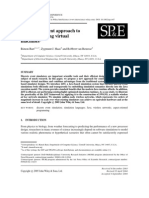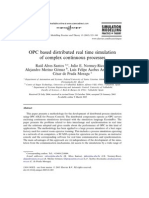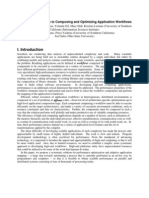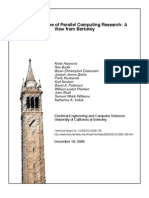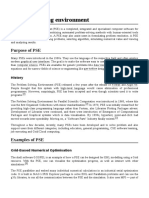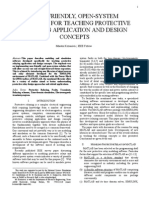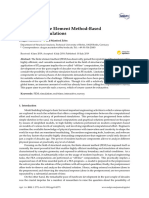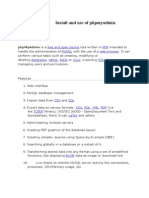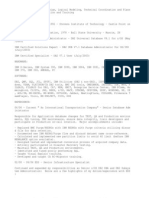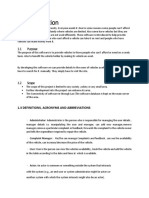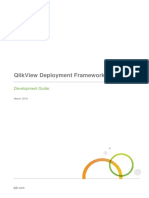lv02 - 25 Nuklir
lv02 - 25 Nuklir
Uploaded by
302345Copyright:
Available Formats
lv02 - 25 Nuklir
lv02 - 25 Nuklir
Uploaded by
302345Original Title
Copyright
Available Formats
Share this document
Did you find this document useful?
Is this content inappropriate?
Copyright:
Available Formats
lv02 - 25 Nuklir
lv02 - 25 Nuklir
Uploaded by
302345Copyright:
Available Formats
Main Menu
Session: 2677
Evaluation of a Flexible Simulator Structure for Nuclear
Engineering Education
Patrick A. Tebbe, Ph.D.
Department of Engineering
The College of Engineering
Ewing, NJ 08628
Abstract
This paper will explore the design and structure of a distributed, multi-code, simulation program
designed specifically for educational purposes. A brief review of current nuclear plant
simulators will be covered. This will be followed by an examination of research aimed at
interfacing a full scope simulator with new desktop interfaces. The results and recent technology
improvements that support the concept of a distributed educational simulator will then be
covered with examples of similar concepts from other fields given for comparison. Lastly the
simulator concept (programming and classroom use) will be more fully described and progress
to-date will be presented.
Introduction
Since the incident at the Three Mile Island nuclear power plant the use of simulation has
been a major component of nuclear power plant operator training. Today all plants maintain a
full scope simulator, which reproduces the thermal hydraulic, reactor physics, and control
functions of the plant. The interface for these simulators is a duplication of the reactor control
room, down to the last meter and switch. In the past these simulators were powered by large
mainframe or minicomputers, while today they can be supplied with data from workstations and
high-end desktop machines.
These advances in computer technology now allow the same fidelity of the full-scope
simulation to be brought into the classroom. In nuclear plants operators must have a knowledge
and understanding of the fundamental processes, as well as the procedures required for plant
operation. Other personnel in the plant also benefit from a greater understanding of how the
plant operates. The same is true of academic education in nuclear engineering, where the
emphasis is on the understanding of theory. However, this type of education differs from the
traditional use of the full scope simulator. The full scope simulator emphasizes the control room
environment and its representation of plant operation (skill-based behavior). This representation
is often not the best suited for building a person's understanding (knowledge-based behavior).
Research indicates that more abstract and hierarchical interfaces, which rely less on real
world fidelity and more on psychological styles, supports knowledge based behavior and
learning [1]. At the same time a high level of computational fidelity is required to obtain the
data powering the interface. From a programming standpoint the best programming structure
Proceedings of the 2002 American Society for Engineering Education Annual Conference & Exposition
Copyright 2002, American Society for Engineering Education
Main Menu
Main Menu
then exhibits a combination of computational abilities and interfacing options. A blending of
programs, languages, and software packages, each tailored to a specific purpose (computation,
interfacing, data storage, etc.) then becomes an attractive alternative to stand-alone, or all-in-one,
simulation programs.
Simulation Background
Simulation has advanced considerably during the last several decades, aided by the increase
in computer speed and the decrease in cost. The first nuclear plant simulator was built by
General Electric for the Dresden 2 plant in 1968. At this time the simulator had limited
capabilities and there were no requirements for modeling fidelity. Following the incident at
Three Mile Island (TMI) in 1979 there has been a concerted effort at improving human
performance. In 1981 all nuclear plants were required to operate plant specific simulators. At
the time of TMI only 12 control room simulators were in use throughout the country [2]. Today
all nuclear plants are required to maintain a full scope control room simulator pursuant to
ANSI/ANS guidelines, either the 1985, 1993, or 1998 specifications. This ANS/ANSI-3.5
standard specifies that each simulator shall be capable of reproducing and predicting in great
detail the operations and variable relationships within the plant [3].
Powering the simulations are a variety of computer programs. Some of the most important
are those which model the thermal hydraulic and reactor physics present in the reactor core.
There are several different codes in use today [4,5]. The National Energy Software Center
maintains numerous programs covering reactor physics, engineering, and design [6]. In addition,
individual plants often have simulation code created specifically for that plant.
When the full scope simulator is being used several different programs and workstations
interact with the same database. This allows different tasks to be divided among different
machines. For instance, a workstation can be established for the instructor. This provides
monitoring of the simulation and allows different scenarios to be created by the instructor.
Another workstation will exchange data between the database and the control boards and panels.
Since the different workstations and programs (i.e. thermal hydraulics, core physics, control
modeling) can interact with a common database through a communications protocol such as a
structured query language they can operate efficiently together as one simulator.
In recent years computational power has increased greatly. Hardware performance (in terms
of CPU and memory) has shown a doubling time of approximately 2 years. Along with this
there has been a shift from mainframe and minicomputers to workstations and high performance
desktop computers. Many utilities are now "porting" their simulation codes to Unix and
Windows NT computers [7,8]. The new desktop capabilities are also fueling the emergence and
use of different types of simulators (part task simulators, basic principle simulators, concept
simulators, and special purpose simulators) [9]. Workstations are proving to be more flexible
than the full scope simulators and interfacing is shifting from text to graphics with these new
capabilities. In support of this the database management systems are also rapidly evolving. In
some cases the simulators can be "enhanced by multimedia applications" to provide a better l ink
to the underlying phenomena [10]. The use of graphical or soft panel controls has existed in
fossil fuel power plants and other industries for many years now. However, due to licensing
Proceedings of the 2002 American Society for Engineering Education Annual Conference & Exposition
Copyright 2002, American Society for Engineering Education
Main Menu
Main Menu
restrictions they have not been applied much in the nuclear power industry. This is now
changing as more graphical interfaces are used in both control rooms and training. The Sta.
Maria de Garona NPP (Burgos, Spain) is developing a prototype control room using touch
screens and graphical interfaces. The control room elements are represented by ActiveX
components developed in Visual C++ and Visual Basic. A DDE server manages communication
between the interface objects and the OpenSim environment [11].
Initial Research
Academia is also making good use of computer simulation in the education of future nuclear
engineers. Simulations can give the students a better understanding of the highly coupled
variable relationships in a nuclear reaction [12]. In some cases old control room simulators from
industry have found their way into academic settings [13]. However, many nuclear programs
and individual courses still make use of older, more simplified, simulation codes. The origin of
this work began as a project to examine how these older codes could be replaced or updated,
mainly in order to improve the interfacing options. It was quickly realized that there was a
parallel effort in the local nuclear industry to create new interfacing options for their programs as
well.
In conjunction with the simulation staff of the Callaway Nuclear Power Station initial
research was conducted into accessing the full scope simulator data with other computer
programs. This was done in support of Callaways efforts at creating a desktop variant of the full
scope simulator and the University of Missouri Columbias efforts to improve classroom
instruction. Following the concept often used for full scope simulators the interface was
designed to interact with a database or other forms of shared memory. In this manner the actual
data could be supplied from any computation source which was capable of interfacing with the
database. The same interface could then be used with the full scope simulator and with older
codes developed at the University.
To construct the interface the LabVIEW so ftware package was chosen. While this software
is traditionally used for data acquisition and controls it offers several advantages to this project.
User interfaces can be easily produced using a point and click method. A wide range of common
controls and indicators are already provided for this purpose. The software also comes equipped
with various options for interfacing with data sources and other programs. Most importantly,
however, both the Callaway plant and the Nuclear Engineering program were c urrently
examining LabVIEW for other uses and this project fit in nicely with those plans.
Before the interface could be created the form of the data storage needed to be specified.
Several interfacing options were explored including TCP/IP, Dynamic Data Exchange (DDE),
and Open Database Connectivity (ODBC). It was determined that a common database format
that could interact with a structured query language (SQL) would be the best choice. For
simplicity a Microsoft Access database was then selected.
In order to test the interface certain functions were selected to be displayed. For output
display several core variables were chosen, including temperature and flux. For input control the
position of the control rods were simulated (Fig. 1). Options were specified so that the core data
Proceedings of the 2002 American Society for Engineering Education Annual Conference & Exposition
Copyright 2002, American Society for Engineering Education
Main Menu
Main Menu
could be displayed as a three-dimensional contour or as an intensity plot, for a selected core
slab. The control rod indicators were constructed similarly to the actual indicators in the plant
and the input device reproduced the lever used in the control room. Appropriate options were
incorporated so that the lever would change appearance when pressed up or down and would
operate the same as the real lever.
At the time this program was constructed it was not possib le to test it dynamically with the
full scope simulator, due to hardware and software licensing limitations. Instead the Access
database was populated with dummy data taken from actual runs of the full scope simulator.
This was deemed sufficient as the simulator was already known to interface properly with the
database and what was needed was a verification of the new interface.
All of the evaluation goals of the initial research were met. However, several potential
problems with full implementation were discovered. While the SQL commands used were very
convenient there was the possibility of a serious time lag due to lengthy SQL searches. This was
caused in part by the extreme size of the normal simulator database. By splitting up the key
variables (temperature, flux, rod position, etc.) into individual Access tables this problem was
largely resolved. A second time problem existed with the lever control. The visual update of the
lever had a to 1 second lag at times, more than long enough for the eye to catch. It was
Figure 1: User interface developed to work with the full scope simulator data.
Proceedings of the 2002 American Society for Engineering Education Annual Conference & Exposition
Copyright 2002, American Society for Engineering Education
Main Menu
Main Menu
determined that this was largely due to inefficient LabVIEW programming and could be fixed
with coding improvements.
Future Development Concept
Following the initial research the goals were reevaluated and the possibilities for the future
were examined. It was realized that interfaces of this sort offered possibilities beyond the
computational options available from older, existing programs. However, use of the full scope
simulator programs was not possible, mainly due to licensing issues with the software and
performance issues with the hardware. The task of creating all new coding which modeled the
plant more in-depth appeared to be a sizable and daunting project. A solution was needed which
offered comprehensive and realistic data, did not require extensive software or hardware
resources, and which was not an all-or-nothing programming project. The solution was found in
an extension of the original full scope simulators distributed architecture.
As already described, many full scope simulators are actually a combination of programs
which interact with a shared memory location or a database. The user interface that was
developed was based on this format. An extension of this program distribution is to also divide
the computations among various pieces of hardware. This approach has already been
demonstrated by other researchers who have created a PWR simulator with high processing
performance using low cost hardware [14]. The same concept has been applied to the Modular
Modeling System (MMS) which is used by industry to model power plants. By integrating
remote access and control methods the MMS models can be integrated with a wide range of
interface options [15].
In order to achieve all of our educational objectives this distributed concept was taken one
step further. If students could access the simulator from any location remotely it was felt they
would be more apt to make use of it. The key limitation would be the manner in which the interprocess communication (IPC) is handled between programs. Fortunately there is an answer to
this with the IEEE Distributed Interactive Simulation (DIS) Protocol. The DIS protocol would
allow the individual components (and data) of our simulator to be linked through the Java
programming language. This approach has already been used in other fields. In particular,
various military organizations around the world use this approach to generate equipment trainers
and battlefield simulations.
Using this method the simulator could be constructed around, or modified to, use of a
standard web browser as the interface mechanism. It also opens up the possibility of
collaborative work on the computations side of the simulator as well. Modules for neutronic
calculations and for thermal hydraulics could be developed and run on computers that are
geographically separated, allowing a pooling of programming and hardware resources. With
regard to classroom use, this approach allows different levels of computational complexity to be
built and different user interfaces to be developed. Individual instructors would then be able to
tailor the program to specific learning objectives.
Proceedings of the 2002 American Society for Engineering Education Annual Conference & Exposition
Copyright 2002, American Society for Engineering Education
Main Menu
Main Menu
Conclusions
Simulation has proven to be a valuable training and educational tool. This is perhaps more
true for nuclear engineering where the opportunities for hands -on learning are limited and
shrinking daily. While the sophistication and capabilities of full scope simulator s has increased
greatly in the last decade the standard nuclear engineering classroom simulator (for knowledge
based learning) has not kept pace. This paper has presented initial research into updating legacy
classroom codes and the technological advancements that allow a new breed of educational
simulator to be constructed. By making use of a distributed simulation environment students
will have easy access to high fidelity simulations. Hardware and software limitations, such as
cost, are bypassed. The resulting simulation will be easily customizable and upgradable and new
possibilities exist for collaboration between academic institutions. To date this approach has not
been explored past the literature research stage. Possible programming collaborations and
testing are possible between the University of Missouri and The College of New Jersey,
however, additional partners may be needed. Currently simulator requirements are being
assessed prior to creating programming action items.
Acknowledgements
The preliminary work presented here was funded through a fellowship from the Institute of Nuclear Power
Operations (INPO) and the University of Missouri Columbia. The assistance of Scott Halverson at the Fulton
(Callaway) Nuclear Power Station was also greatly appreciated.
Bibliography
1.
Vicente, K., Christoffersen, K., and Pereklita, A., Supporting Operator Problem Solving Through Ecological
Interface Design, IEEE Transactions on Systems, Man, and Cybernetics, Vol. 25, 1995.
2.
Smith, R. ed., "Twenty Years Later," The Nuclear Professional, 1st quarter issue, 1999.
3.
ANSI, Nuclear Power Plant Simulators for Use in Operator Training and Examination, revised ANSI/ANS 3.5 standard, 1998.
4.
Agee, L., Overview of Electric Power Research Institute Nuclear Safety Analysis Activities, Nuclear
Technology, Vol. 121, 1998.
5.
Shotkin, L., Development and Assessment of U.S. Nuclear Regulatory Commision Thermal-Hydraulic
System Computer Codes, Nuclear Technology, Vol. 116, 1996.
6.
Glasstone S. and Sesonske, A., Nuclear Reactor Engineering, Chapman and Hall, 4 th edition, Vol. 2., 1996.
7.
Laughton, T., Belblidia, L., Andersen, P., and OFarrell, D., THOR ComEd Advanced Model Simulator
Upgrade, Western Multiconference 2000, Society for Computer Simulation, 2000.
8.
Boire, R., Fourth Generation Full Scope Simulator on Windows NT, Western Multiconference 2000,
Society for Computer Simulation, 2000.
9.
Baumont, G., and Montes, G., Current practices in operator training with simulators in OECD countries,
1997 IEEE 6 th Conference on Human Factors and Power Plants, IEEE, 1997.
10. Bartak, J., Chaumes, P., Gissinger, S., Houard J., and Van Houte, U., Operator Training Tools for the
Competitive Market, Computer Applications in Power, IEEE, Vol. 13, 2000.
11. Corcuera, P., Garces, M., and Ryan, J., A Training Simulator with Soft Panels, Western Multiconference
2000, Society for Computer Simulation, 2000.
12. Doster, J., Simulation as a Tool for Teaching Nuclear Reactor Systems, ANS Transactions, Vol. 81, 1999.
13. Ma, Y. and Edwards, R., Undergraduate Simulator Design Course, ANS Transactions, Vol. 80,1999.
14. Kitamura, M., Ohi, T., Yamamoto, T., and Akagi, K., Development of High Precision Plant Simulator for
Pressurized Water Reactor Plants using Distributed Architecture, Journal of Nuclear Science and
Technology, Vol. 3, 1999.
15. Jones, C.A., Integrating Remote Access & Control Methods into Simulation Models, Nuclear Plant
Journal, July-August, 1994.
Proceedings of the 2002 American Society for Engineering Education Annual Conference & Exposition
Copyright 2002, American Society for Engineering Education
Main Menu
Main Menu
PATRICK A. TEBBE
Patrick Tebbe is an Assistant Professor of Mechanical Engineering at The College of New Jersey. Patrick teaches
undergraduate thermodynamics and thermal sciences laboratories. He received his Ph.D. in Mechanical Engineering
from the University of Missouri-Columbia in 1997. Before moving to New Jersey he served as an Adjunct Assistant
Professor at Missouri and also completed a M.S. in Nuclear Engineering. He is a member of ASME, ASEE, and
ANS where he currently serves as the Secretary/Treasurer for the Human Factors Division.
Proceedings of the 2002 American Society for Engineering Education Annual Conference & Exposition
Copyright 2002, American Society for Engineering Education
Main Menu
You might also like
- A Survey of Parallel Programming Models and Tools in The Multi and Many-Core EraDocument18 pagesA Survey of Parallel Programming Models and Tools in The Multi and Many-Core Eraramon91No ratings yet
- CAD Primer PDFDocument106 pagesCAD Primer PDFbhaskarjalanNo ratings yet
- Jist: An Efficient Approach To Simulation Using Virtual MachinesDocument38 pagesJist: An Efficient Approach To Simulation Using Virtual Machinesapi-3706266No ratings yet
- Computational Modular Model Library of GDocument8 pagesComputational Modular Model Library of GLuis Antonio CNo ratings yet
- The Performance and Energy Consumption of Three Embedded Real-Time Operating SystemsDocument8 pagesThe Performance and Energy Consumption of Three Embedded Real-Time Operating SystemssnathickNo ratings yet
- Computação ParalelaDocument18 pagesComputação ParalelaGuilherme AlminhanaNo ratings yet
- OpenFOAM A C++ Library For Complex Physics SimulationsDocument20 pagesOpenFOAM A C++ Library For Complex Physics SimulationsAghajaniNo ratings yet
- OPC Based Distributed Real Time Simulation of Complex Continuous ProcessesDocument25 pagesOPC Based Distributed Real Time Simulation of Complex Continuous Processessina20795No ratings yet
- Eucalyptus: An Open-Source Cloud Computing InfrastructureDocument15 pagesEucalyptus: An Open-Source Cloud Computing InfrastructureMurali ManoharaNo ratings yet
- A Systematic Approach To Composing and Optimizing Application WorkflowsDocument9 pagesA Systematic Approach To Composing and Optimizing Application WorkflowsLeo Kwee WahNo ratings yet
- Model Based Systems Engineering For Aircraft Systems - How DoesDocument9 pagesModel Based Systems Engineering For Aircraft Systems - How DoesAlmas QasimNo ratings yet
- Enterprise CAS94Document8 pagesEnterprise CAS94Max TanNo ratings yet
- Research Article: Towards The Concurrent Optimization of The Server: A Case Study On Sport Health SimulationDocument13 pagesResearch Article: Towards The Concurrent Optimization of The Server: A Case Study On Sport Health Simulationashantymaranguez18No ratings yet
- 1 s2.0 S0167739X15003362 MainDocument18 pages1 s2.0 S0167739X15003362 MaingmgaargiNo ratings yet
- VMaa Ai TCCDocument5 pagesVMaa Ai TCCfrancesco_pedullaNo ratings yet
- High Performance Computing in Power System Applications.: September 1996Document24 pagesHigh Performance Computing in Power System Applications.: September 1996Ahmed adelNo ratings yet
- Grid Computing: Techniques and Applications Barry WilkinsonDocument34 pagesGrid Computing: Techniques and Applications Barry WilkinsonKali DasNo ratings yet
- Chapter 1Document25 pagesChapter 1chinmayNo ratings yet
- The Landscape of Parallel Computing Research: A View From BerkeleyDocument56 pagesThe Landscape of Parallel Computing Research: A View From BerkeleyDima LitvinovNo ratings yet
- Modeling and Simulation of Aircraft EnginesDocument12 pagesModeling and Simulation of Aircraft EnginesEnrique MartinezNo ratings yet
- Parallelization of Swarm Intelligence Algorithms: Literature ReviewDocument29 pagesParallelization of Swarm Intelligence Algorithms: Literature ReviewЮрій ДоротякNo ratings yet
- Hybrid Simulation Combined With Fatigue Testing Method: Shawn S. You, X. Shawn GaoDocument9 pagesHybrid Simulation Combined With Fatigue Testing Method: Shawn S. You, X. Shawn GaoJohnny Condori UribeNo ratings yet
- Composing Modeling and Simulation With Machine Learning in JuliaDocument11 pagesComposing Modeling and Simulation With Machine Learning in Juliaachraf NagihiNo ratings yet
- Debaun 2005Document13 pagesDebaun 2005arminNo ratings yet
- Problem Solving EnvironmentDocument5 pagesProblem Solving Environmentcharlotte899No ratings yet
- An Experimental Comparison of Different Real Time S 2012 Journal of SystemsDocument12 pagesAn Experimental Comparison of Different Real Time S 2012 Journal of SystemsnausicaatetooNo ratings yet
- Navya2022 Chapter ComparativeStudyOfDirective-baDocument13 pagesNavya2022 Chapter ComparativeStudyOfDirective-baEbtsam DosokyNo ratings yet
- A Framework For Programming Embedded Systems: Initial Design and ResultsDocument47 pagesA Framework For Programming Embedded Systems: Initial Design and ResultsBillow Kenny KucchinsNo ratings yet
- Unit 1Document22 pagesUnit 1HariniNo ratings yet
- Ecmfa 2019Document12 pagesEcmfa 2019Manabendra M DeNo ratings yet
- A User-Friendly Dynamic Reactor Simulator Built inDocument6 pagesA User-Friendly Dynamic Reactor Simulator Built inprajwalhghadge17No ratings yet
- Simulation Software For Teaching Dynamic System BehaviourDocument13 pagesSimulation Software For Teaching Dynamic System Behaviourpasha.baileyNo ratings yet
- User Friendly KezunovicDocument8 pagesUser Friendly KezunovicLucian2001No ratings yet
- Definition: Higher Speed, or Solving Problems FasterDocument4 pagesDefinition: Higher Speed, or Solving Problems FasterWerda FarooqNo ratings yet
- Achieving High Performance ComputingDocument58 pagesAchieving High Performance ComputingIshamNo ratings yet
- Development of A Real-Time Digital Control System With A Hardware-in-the-Loop Magnetic Levitation Device For Reinforcement of Controls EducationDocument9 pagesDevelopment of A Real-Time Digital Control System With A Hardware-in-the-Loop Magnetic Levitation Device For Reinforcement of Controls EducationJacobo Javier Cáceres RodríguezNo ratings yet
- Modelica Programming A New Approach in Modeling of CHP: Bahman ZohuriDocument12 pagesModelica Programming A New Approach in Modeling of CHP: Bahman Zohuridawing david guette tuiranNo ratings yet
- Simulation Tools For Power Electronics-"An Overview"Document4 pagesSimulation Tools For Power Electronics-"An Overview"raghuevmNo ratings yet
- High Performance ComputingDocument164 pagesHigh Performance Computingtpabbas100% (2)
- Early Simulation and Testing of Virtual ECUs For Electric VehiclesDocument12 pagesEarly Simulation and Testing of Virtual ECUs For Electric VehiclesLars StockmannNo ratings yet
- Real-Time Implementation of Low-Cost University Satellite 3-Axis Attitude Determination and Control SystemDocument10 pagesReal-Time Implementation of Low-Cost University Satellite 3-Axis Attitude Determination and Control SystemivosyNo ratings yet
- Science in The Clouds: History, Challenges, and OpportunitiesDocument59 pagesScience in The Clouds: History, Challenges, and OpportunitiesQamar NangrajNo ratings yet
- Analysis and Simulation of Mixed-Technology VLSI SystemsDocument26 pagesAnalysis and Simulation of Mixed-Technology VLSI SystemscoralonsoNo ratings yet
- 1 s2.0 S0167739X23000511 MainDocument14 pages1 s2.0 S0167739X23000511 MainWilson IriarteNo ratings yet
- IOSR JournalsDocument8 pagesIOSR JournalsInternational Organization of Scientific Research (IOSR)No ratings yet
- A Versatile Demonstrator For Distributed RealDocument4 pagesA Versatile Demonstrator For Distributed Realpriyanka1229No ratings yet
- Applsci 09 02775Document15 pagesApplsci 09 02775Maciej KotNo ratings yet
- Pub Grid ComputingDocument330 pagesPub Grid ComputingjayNo ratings yet
- Article 1 R-E-W HeuristicDocument11 pagesArticle 1 R-E-W HeuristichelinNo ratings yet
- Preface: PurposeDocument5 pagesPreface: PurposeHarish BheemaiahNo ratings yet
- Anyplace - An Energy Management System To Enhance Demand Response ParticipationDocument6 pagesAnyplace - An Energy Management System To Enhance Demand Response Participationhuolongguo96No ratings yet
- Idaasd 2Document9 pagesIdaasd 2Eddy SoenNo ratings yet
- Distributed Large-Scale Co-Simulation For Iot-Aided Smart Grid ControlDocument10 pagesDistributed Large-Scale Co-Simulation For Iot-Aided Smart Grid ControldikyNo ratings yet
- 2008 01 ConfigDocument2 pages2008 01 ConfigDamodar TeluNo ratings yet
- A Light-Weight Approach To Dynamical Runtime Linking Supporting Heterogenous, Parallel, and Reconfigurable ArchitecturesDocument12 pagesA Light-Weight Approach To Dynamical Runtime Linking Supporting Heterogenous, Parallel, and Reconfigurable ArchitecturesAbhishek ChaturvediNo ratings yet
- Simulation For Multiprocessor Real-Time Scheduling EvaluationDocument6 pagesSimulation For Multiprocessor Real-Time Scheduling EvaluationHareesh ArjunNo ratings yet
- Effective Performance Measurement and Analysis of Multithreaded Applications NathanDocument11 pagesEffective Performance Measurement and Analysis of Multithreaded Applications Nathanapi-12797690No ratings yet
- Anyplace - An Energy Management System To Enhance Demand Response ParticipationDocument6 pagesAnyplace - An Energy Management System To Enhance Demand Response ParticipationSumit RathorNo ratings yet
- A New Approach To The Design of DistribuDocument20 pagesA New Approach To The Design of DistribukevinalleinNo ratings yet
- Computers in Industry: Y.-S. Ma, S.-H. Tang, C.K. Au, J.-Y. ChenDocument11 pagesComputers in Industry: Y.-S. Ma, S.-H. Tang, C.K. Au, J.-Y. Chensomeshch1No ratings yet
- Energy Efficient High Performance Processors: Recent Approaches for Designing Green High Performance ComputingFrom EverandEnergy Efficient High Performance Processors: Recent Approaches for Designing Green High Performance ComputingNo ratings yet
- Student Marks Management SystemDocument24 pagesStudent Marks Management SystemManav JinNo ratings yet
- Oracle Certkey 1z0-082 v2021-04-27 by Lucas 58qDocument36 pagesOracle Certkey 1z0-082 v2021-04-27 by Lucas 58qemansaleh1306No ratings yet
- A Complete Reference For Informatica Power Center ETL ToolDocument8 pagesA Complete Reference For Informatica Power Center ETL ToolEditor IJTSRDNo ratings yet
- ME CSE SyllabusDocument65 pagesME CSE SyllabusjayarajmeNo ratings yet
- UntitledDocument22 pagesUntitledVanderlan Dos Santos RamosNo ratings yet
- Data GuardDocument282 pagesData Guardankur singhNo ratings yet
- PPD Pract-3Document8 pagesPPD Pract-3jayNo ratings yet
- Sr. Mainframe DB2 Database AdministratorDocument5 pagesSr. Mainframe DB2 Database Administratorapi-77410409No ratings yet
- Unit 3 - Databases PDFDocument24 pagesUnit 3 - Databases PDFYakubNo ratings yet
- Performance Management PlanDocument14 pagesPerformance Management Planmkpasha55mpNo ratings yet
- Dell BOOMi Cloud Integration Online TraiDocument8 pagesDell BOOMi Cloud Integration Online Traisotawat519No ratings yet
- Scooter Lending SRSDocument11 pagesScooter Lending SRSAmar SomaniNo ratings yet
- AVEVA Integration Service Setup Guide 2.3Document111 pagesAVEVA Integration Service Setup Guide 2.3Habib FaridoonNo ratings yet
- Release NotesDocument40 pagesRelease Notes11804No ratings yet
- QlikView Deployment Framework-Development Guide7Document59 pagesQlikView Deployment Framework-Development Guide7Demos ManarNo ratings yet
- Sop 1Document2 pagesSop 1api-3799966100% (10)
- Data AnalystDocument6 pagesData AnalystJean JagguNo ratings yet
- Csec It Sba 2022 Database ManagementDocument4 pagesCsec It Sba 2022 Database ManagementJanicSmithNo ratings yet
- Exploratory Research Design: Secondary DataDocument24 pagesExploratory Research Design: Secondary DataBadsha FoysalNo ratings yet
- Water Resources Should Be Nationalised - Group DiscussionDocument11 pagesWater Resources Should Be Nationalised - Group DiscussionSwetha ReddyNo ratings yet
- Lab01 MysqlDocument4 pagesLab01 MysqlPhạm Trung KiênNo ratings yet
- Unit 4 Software Agent and PrologDocument18 pagesUnit 4 Software Agent and PrologShashank SharmaNo ratings yet
- Oracle Database 11g: SQL Tuning Workshop: DurationDocument4 pagesOracle Database 11g: SQL Tuning Workshop: DurationCharles G GalaxyaanNo ratings yet
- FINALDOCUCAPSTONEDocument80 pagesFINALDOCUCAPSTONEpachet dabaNo ratings yet
- OmniBase TutorialDocument7 pagesOmniBase Tutorialapi-3704583No ratings yet
- Babylon-Enterprise Administrator GuideDocument168 pagesBabylon-Enterprise Administrator GuideLouR2011No ratings yet
- Unit 3 Data Mining PDFDocument19 pagesUnit 3 Data Mining PDFshamiruksha katarakiNo ratings yet
- Question Bank 2023-24 Computer ScienceDocument146 pagesQuestion Bank 2023-24 Computer Sciencekalpanapradhan1179No ratings yet
- Big Data Question BankDocument38 pagesBig Data Question Bankindrajeet007No ratings yet


